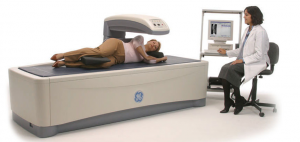Bone densitometry

Bone densitometry is a technique used to diagnose osteoporosis. This exam enables a doctor to measure the exact content of calcium in the bones.
The exam is done using a DEXA method, with which it is possible to evaluate the degree of mineralization of the bones of the lumbar spine, the femur, the wrist, the hip or of the whole skeleton (”total body” bone densitometry).
Bone densitometry is very precise, and shows early alterations of bone tissue when mineral loss (osteopenia) is still in an initial stage. This exam does not need any preparation, does not take much time and, once finished, the patient can immediately return to his/her normal life.
The exam is painless and without risks. Thanks to this test it is possible to:
- evaluate your fracture risk;
- decide if and which therapeutic measures are necessary;
- monitor therapeutic measures;
- verify therapeutic effectiveness.
Bone density values are then compared in a reference curve with those of a person of the same age and sex.
The results of a densitometry may be:
- in the norm (the suspect of osteoporosis is not confirmed);
- osteopenia (bone density is only slightly reduced);
- osteoporosis (reduction of bone density is evident or remarkable).
